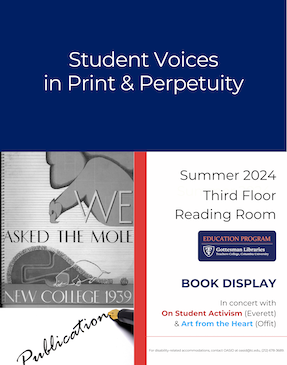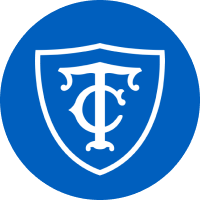New Book Display: Student Voices in Print and Perpetuity
Curiosity Cabinets
By the rhythmic and patterned movement of a thought seeking an outer contact, then returning to its creator enriched, changed or diverted, it can become dynamic and pass into action.
– Bob Brubacher, et al. We Asked the Mole, New College, 1939
Introduction
Student Voices in Print and Perpetuity showcases an extraordinary range of Teachers College student publications from the early 1900s to the present day, with examples of yearbooks, literary and art magazines, newsletters, bulletins, and books – all of which show the vital role that students play; they inform their peers and community about campus events and occurrences; raise political, economic, and socio-cultural concerns; and share their creative talents, often built upon the curriculum. They learn to think, create, and act upon their values, opinions, beliefs, and perspectives while becoming leaders for change. In representing both the individual and collective perspective and actions of students within the context of education, the student voice serves to awaken us to the complexities of ourselves, our societies, and our world, as their publications provide a tangible record.
Experimental and Demonstration Schools
Shown are works produced by elementary and secondary school children, as well as undergraduates in schools owned and operated by Teachers College, Columbia University which throughout its history looked to test and model new and progressive philosophies and practices.
Founded in 1887 by Nicholas Murry Butler, Horace Mann School was originally located at 9 University Place (site of then New York College for the Training of Teachers) before moving in 1901 to the corner of 120th Street and Broadway. In 1913 it split into separate all-male and all-female schools – well equipped with access to modern facilities that included a library, gymnasium and auditorium.
Established with funding from John D. Rockefeller in 1917, The Lincoln School similarly was a private, progressive, coeducational grade school that served as a leading laboratory for curriculum and public education policies. It opened at 646 Park Avenue, then moved to a larger site at 425 West 123rd Street (currently P.S.125, Ralph Bunche). Beset by contradictory approaches to education and syllabi – the infusion of more vocational than classical learning (modern math and science as opposed to classical Greek and Latin) – it merged with the Horace Mann School for Girls in 1940.
With learning communities established in North Carolina, Georgia, and abroad in foreign study groups, New College for the Education of Teachers (New College) was a progressive institution that offered a Bachelor of Science and/or a master's degree after a period of study from three to five years. It existed from 1932 to 1939, helping prepare young people for teaching positions in elementary and secondary grades, while being a demonstration college for graduate students in Teachers College. It was known for holistic learning – one that blended the classroom with art, work, and real life experience. Said students, “We are preparing not only to be teachers in a narrow sense, but to be active participants in the community in which we will work and assume educational leadership. We have a special concern for reconstructing educational institutions in light of the needs of a changing civilization.”
Read ore on Experimental and Demonstration Schools.
Mainstream TC
Displayed are more traditional examples of student works. The yearbook of Teachers College went through various title changes (Senior Class Book; The Tower, named after the Russell Hall Bell Tower; and Teecean), before ceasing publication by the late 1920s. Other publications followed, including digests, newsletters, forums, and journals, some specific to academic programs, such as Nursing Education. The creative spirit was nurtured by students of English taught by Dr. Ida A. Jewett, alumna, and Assistant Professor of English, 1928-1948.
Explore Teachers College Yearbooks and Ephemera.
Activism to Artivism and the New Aesthetic
In the mid-1930s, and again in the late 1960s-early 1970s, students of Teachers College brought their viewpoints and counter viewpoints on societal and world issues to the forefront. Activism took on a new dimension. There was growing unrest on the Columbia University campus, as well as at other universities – all coping with the impact of the Second Red Scare, or McCarthyism (1939-1945); Vietnam War (1955-1974) and draft; and ongoing racial discrimination fueling the Civil Rights Movement (1954-1968).
In 2024, as we launch the new Offit Gallery exhibit, Artivism: Art from the Heart, we underscore the importance of process, rather than product. After all, it is not the actual publication or artwork itself that is most significant – rather, the conception and giving of our voice as expressed through writing or another medium. Artivism: The Power of Art for Social Transformation is a TC alumni movement that “aims to generate community through multidisciplinary teamwork for a more dignified and meaningful coexistence. Its overarching goal is to nurture confidence in taking continuous action from wherever we are by means of reciprocity.”
These exhibits complement Thinking, Acting, and Learning: On Student Activism, a new Everett Cafe book display that explores different facets of student activism, from its historical example in the United States, to its reach and influence across the globe.
Student Voices in Print and Perpetuity is on display in the Third Floor Curiosity Cabinets through the Summer.


